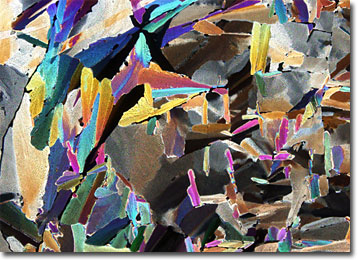Polarized Light Microscopy Digital Image Gallery
Glutamic Acid
Primarily utilized in the body to build proteins, glutamic acid is an important and widely distributed amino acid. However, most people are more likely to be familiar with a salt of glutamic acid, monosodium glutamate (MSG), which is sometimes used as a preservative and condiment for flavoring foods, especially Chinese cuisine.

First isolated in 1865, glutamic acid is one of only two amino acids that exhibit a net negative charge at physiological pH, a characteristic that stems from a carboxylic acid moiety on the side chain of the molecule. This negative charge makes glutamic acid a very polar molecule. Consequently, the amino acid is usually found on the outside of proteins and enzymes where it is free to interact with the aqueous intracellular milieu.
Although it is a significant metabolic intermediate, glutamic acid does not need to be consumed as part of one’s diet because it is readily biosynthesized in animals during the metabolism of carbohydrates. Nevertheless, the amino acid commonly occurs in plants. In fact, some plant proteins bear nearly half their body weight as glutamic acid, though 10 to 20 percent is more typical. A significant part of the glutamic acid content in plant proteins derives from glutamine, a highly prevalent amino acid that converts to glutamic acid when protein hydrolyzation takes place.
